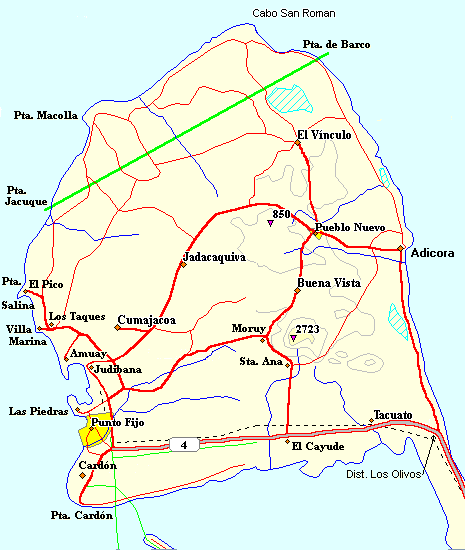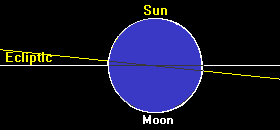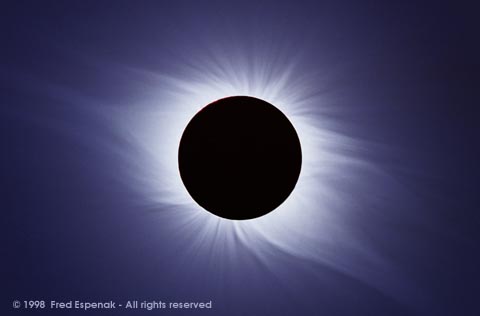



Location: Paraguaná, Venezuela
(North is up)
![]() This map of the peninsula of Paraguaná shows in green color the Central Line of the eclipse.
This map of the peninsula of Paraguaná shows in green color the Central Line of the eclipse.
The shadow of totality moved from Southwest to Northeast, spanning the entire peninsula,
but did not reach to the city of Coro.
![]() We established ARVAL's observation site at Punta de Barco, on the Easternmost road
crossed by the Central Line, at sea level, in the radio station 'La Voz de Venezuela',
offering a good view of the Northeast coast, and the beaches.
We established ARVAL's observation site at Punta de Barco, on the Easternmost road
crossed by the Central Line, at sea level, in the radio station 'La Voz de Venezuela',
offering a good view of the Northeast coast, and the beaches.
![]() On Thursday, 1998 February 26, a total eclipse of the Sun was visible from within a narrow
corridor which traversed the Western Hemisphere.
On Thursday, 1998 February 26, a total eclipse of the Sun was visible from within a narrow
corridor which traversed the Western Hemisphere.
The path of the Moon's umbral shadow began in the Pacific, continued through northern South
America and the Caribbean Sea, and ended at sunset off the Atlantic coast of Africa.
A partial eclipse was seen within the much broader path of the Moon's penumbral shadow, which
included parts of the United States and eastern Canada, Mexico, Central America and the
northern half of South America.
![]() Southeast of Paraguaná, the Galapagos Islands, the South of Panama, and the North of Colombia,
also experienced totality.
Southeast of Paraguaná, the Galapagos Islands, the South of Panama, and the North of Colombia,
also experienced totality.
![]() At the West side of the Gulf of Venezuela, the totality spanned the city of Maracaibo and the
towns from Rosario to Maicao, but not Cabimas.
At the West side of the Gulf of Venezuela, the totality spanned the city of Maracaibo and the
towns from Rosario to Maicao, but not Cabimas.
![]() Northeast of Paraguaná, the islands of Aruba, Curaçao, Bonaire, Montserrat, Antigua, and
Guadeloupe, also experienced totality.
Northeast of Paraguaná, the islands of Aruba, Curaçao, Bonaire, Montserrat, Antigua, and
Guadeloupe, also experienced totality.
NASA - Feb. '98 Eclipse (Home Page)
![]() Total Eclipse of the Sun on Thursday February 26th 1998:
Total Eclipse of the Sun on Thursday February 26th 1998:
Lat. 12° 9.88' N, Lon. 69° 55.9' W, 0m above sea level
(Punta de Barco, on the eclipse Central Line)

Venezuela (UTC - 4hrs.) local times:
Eclipse started: 12:38:20 (First Contact, Height 69°)
Totality started: 14:09:18 (Second Contact)
Center of Totality: 14:11:10 (Height 62°)
End of Totality: 14:13:02 (Third Contact)
End of Eclipse: 15:35:43 (Fourth Contact, Height 45°)
Duration of Totality: 3 min. 44 sec.
Data was projected using the Solar Eclipse Predictor v 1.0, by Worachate Boonplod.
Sun's Position at 14:11 (Local time), 23:57 Local Sidereal Time:
R.A.: 22h 38m 25s Dec: 8° 35' 29" S
Azimuth: 224° 6' Height: 61° 32'
The Sun rose at 06:56, transited at 12:52, and set at 18:48
Data was projected using TheSky, version 4, Software Bisque.
What did totality look like?
Observatorio ARVAL: Total Eclipse of the Sun, February 26 '98 - Images & Meteorologic Data
Staigerland Eclipse '98
Solar Eclipse '98 - Live @ The Exploratorium
Bob Yen, Total Solar Eclipse, Feb. 26 '98
(High resolution film images were posted here after the eclipse)
Reports of the
1998 Total Solar Eclipse (Fred Espenak)
LIVE! ECLIPSE 98 on February 26, 1998
Index of \pub\goes\980226 NASA - Goddard Space Flight Center - GOES Images & Movies
Fred Espenak:

"Although Solar eclipses are easily photographed, it's nearly impossible to capture details in both the inner and outer corona in any single exposure. The corona's range in brightness is just too large for the dynamic range of today's photographic emulsions."
"In recent years, eclipse photographers have begun processing their images using the personal computer and image editing programs like Adobe Photoshop."
"This is one of my first efforts in eclipse photography composite imaging. The original images were made by me from Oranjestad, Aruba during the total Solar eclipse of 1998, February 26. A Sigma 400mm f/5.6 APO telephoto and a Sigma 2X teleconverter were used with a Nikon FE w/MD-12 motor drive. The exposures were made on Kodak Royal Gold 100 at 2, 1, 1/2, 1/4, 1/8, 1/15 and 1/125 seconds. I scanned the negatives using a Minolta QuickScan 35."
Visit
Fred Espenak's Web page on Solar Eclipse Composite Photography
Mercury, Jupiter, Venus, Mars, and Fomalhaut were apparent near the Sun during Totality:
![]() Mercury; Some 4° East of the Sun, apparent Magnitude: -1.6
Mercury; Some 4° East of the Sun, apparent Magnitude: -1.6
![]() Jupiter; Some 3° West of the Sun, apparent Magnitude: -2
Jupiter; Some 3° West of the Sun, apparent Magnitude: -2
![]() Venus; Some 42° East of the Sun, apparent Magnitude: -4.6
Venus; Some 42° East of the Sun, apparent Magnitude: -4.6
![]() Mars; Some 17° East of the Sun, apparent Magnitude: 1.2
Mars; Some 17° East of the Sun, apparent Magnitude: 1.2
![]() Fomalhaut; Some 22° South of the Sun, apparent Magnitude: 1.3
Fomalhaut; Some 22° South of the Sun, apparent Magnitude: 1.3
![]() Other WWW sites with more information on this eclipse:
Other WWW sites with more information on this eclipse:
NASA - Feb. '98 Eclipse
NASA Eclipse Web Site
Eclipse Solar 1998 (Venezuela) (COVESOL '98)
Solar-Eclipse Preview: February 26, 1998
(at Sky & Telescope, by Fred Espenak)
Solar Eclipse: February 26, 1998
(Astronomy Magazine)
The Eclipse Chaser home page (Jeffrey R. Charles)
Observatorio ARVAL: Paraguaná - Total Eclipse of the Sun
- February 26 '98 (ARVAL's team technical page, in English)
Wendy Carlos, Eclipse Feb. 1998
![]() Warning:
Warning:
Never observe the Sun directly, nor with optical instruments, without the required special
filters, this would result in permanent damage to your eyesight.
To observe an eclipse during its partial phases, without optical instruments, project a small
image of the Sun on a screen of white cardboard, using as a "lens" a tiny hole punctured with
a needle in a sheet of aluminum foil.
Set the screen perpendicular to the Sun rays, and the aluminum foil between the screen and the
Sun, parallel to the screen. The distance between the "lens" and the screen determines the
size and brightness of the image.
Mounting the aluminum foil on a light frame, will make it easier to handle. Supporting the
screen on its correct position, will make this device easier to handle.
Constructing the whole device inside a shoebox, with only a sighthole on one of the sides
lets you attain a larger image. Cut a hole into one end to support a small piece of foil with
the pinhole.
An arc-soldering filter #14, or a special Mylar filter, lets you look at the Sun directly.
Be sure to protect and instruct your children!
The damage to your eyesight occurs without pain!
Only during the totality, it is safe to observe an eclipse directly, or with optical
instruments.
But beware of the end of the totality!
![]() Updated: March 26 '98
Updated: March 26 '98
Best seen with MS Internet Explorer.
Cambiar a: versión en Castellano de esta página
Back: ARVAL - Image Gallery Solar Eclipse '98
Messages: